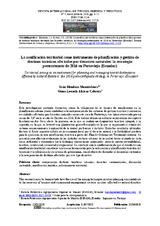Mostrar el registro sencillo del ítem
La zonificación territorial como instrumento de planificación y gestión de destinos turísticos afectados por desastres naturales: la estrategia posterremoto de 2016 en Portoviejo (Ecuador)
| dc.contributor.author | Mendoza Montesdeoca, Iván | |
| dc.contributor.author | Alcívar Cabrera, Gema Leonela | |
| dc.date.accessioned | 2020-06-29T09:22:22Z | |
| dc.date.available | 2020-06-29T09:22:22Z | |
| dc.date.issued | 2020 | |
| dc.identifier.issn | 2530-7134 | |
| dc.identifier.uri | http://hdl.handle.net/10396/20220 | |
| dc.description.abstract | Esta investigación pretende demostrar cómo la utilización de la técnica de zonificación en la planificación urbana puede contribuir a la recuperación de los sistemas de gestión turística y comercial en ciudades afectadas por desastres naturales como este caso de Portoviejo, tras haber atravesado por un sismo de 7,8º en la escala de Richter en 2016. Este trabajo utiliza un enfoque exploratorio descriptivo diseñado en dos fases clave: la primera, en la que se realizó un diagnóstico turístico integral, y la segunda, en la que se levantó una planimetría georreferenciada en la que se representó el estado del sistema socioeconómico y ambiental de la ciudad por barrios y distritos. Entre los resultados obtenidos destaca el fuerte impacto sufrido en la economía local por el desastre natural y la factibilidad positiva para la ejecución de una zonificación turística a partir del Plan de Ordenación Territorial cantonal. Se procedió para ello una evaluación de los distintos sectores urbanos de la ciudad desde el punto de vista socio ambiental y económico hasta distinguir cuatro zonas principales: zona de mayor sostenibilidad; turística; residencial; comercial y empresarial. Se concluye con la confirmación de que el diseño de una zonificación territorial constituye una buena herramienta para la ordenación y planificación turística del territorio y la eficiencia de su sistema de gobernanza, con el objeto de fomentar el desarrollo sostenible y la recuperación de destinos afectados por este tipo desastres. | es_ES |
| dc.description.abstract | This research aims to demonstrate how the use of the zoning technique in urban planning can contribute to the recovery of tourism and commercial management systems in cities affected by natural disasters such as this case of Portoviejo, after having suffered an earthquake of 7.8º on the Richter scale in 2016. This work uses a descriptive exploratory approach designed in two key phases: the first, in which a comprehensive tourist diagnosis was made, and the second, in which a georeferenced planimetry was created in which it represented the state of the city's socioeconomic and environmental system by neighborhoods and districts. Among the results obtained, the strong impact suffered on the local economy by the natural disaster and the positive feasibility for the execution of a tourist zoning based on the Cantonal Territorial Planning. For this, an evaluation of the different urban sectors of the city was carried out from the socio-environmental and economic point of view, until four main areas were distinguished: the area with the greatest sustainability; tour; residential; commercial and business. It concludes with the confirmation that the design of a territorial zoning constitutes a good tool for the tourist planning and organization of the territory and the efficiency of its governance system, in order to promote sustainable development and the recovery of destinations affected by it disaster type. | es_ES |
| dc.format.mimetype | application/pdf | es_ES |
| dc.language.iso | spa | es_ES |
| dc.publisher | UCOPress | es_ES |
| dc.rights | https://creativecommons.org/licenses/by-nc/4.0/ | es_ES |
| dc.source | Revista Internacional de Turismo, Empresa y Territorio (RITUREM) 4(1), 1-21 (2020) | es_ES |
| dc.subject | Recuperación destinos turísticos urbanos | es_ES |
| dc.subject | Desastres socionaturales | es_ES |
| dc.subject | Desarrollo sostenible | es_ES |
| dc.subject | Zonificación turística | es_ES |
| dc.subject | Ordenamiento territorial | es_ES |
| dc.subject | Recovery of urban tourist destinations | es_ES |
| dc.subject | Socio-natural disasters | es_ES |
| dc.subject | Sustainable development | es_ES |
| dc.subject | Tourist zoning | es_ES |
| dc.subject | Territorial planning | es_ES |
| dc.title | La zonificación territorial como instrumento de planificación y gestión de destinos turísticos afectados por desastres naturales: la estrategia posterremoto de 2016 en Portoviejo (Ecuador) | es_ES |
| dc.title.alternative | Territorial zoning as an instrument for planning and managing tourist destinations affected by natural disasters: the 2016 post-earthquake strategy in Portoviejo (Ecuador) | es_ES |
| dc.type | info:eu-repo/semantics/article | es_ES |
| dc.relation.publisherversion | http://www.uco.es/ucopress/ojs/index.php/riturem/index | es_ES |
| dc.rights.accessRights | info:eu-repo/semantics/openAccess | es_ES |

